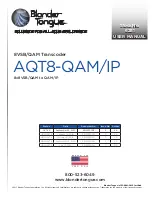
9
AQT8-QAM/IP
User Manual
INPUT POWER ASSEMBLY AND FUSE:
IEC 14 power inlet plug – rated 110-230 VAC; 0.7/0.35; 60/50 Hz; equipped
with Slo-Blo, 3.0A, 250 V Fuse.
EAS TRIGGER CONTACTS:
Terminal strip will activate the EAS
messaging feature in the following ways:
a) 5-12 VDC between terminals 1 & 3 shown to the right.
b) Dry Contact between terminals 2 & 3 shown to the right.
NOTE:
This feature activates EAS and overrides all the input programs with the EAS INPUT (see and below
for details). When in "RF Default" mode, the EAS program substitution is for IP outputs only. EAS messaging is
available on the IP and QAM outputs when the QAM Output Mode is set to "Default IP" or "IP#". There will be no EAS
messaging on the QAM output channels when in the "RF Default" mode.
EAS ASI IN:
SPTS EAS input stream.
EAS 10/100 IP EAS INPUT:
SPTS EAS IP input.
QAM Output:
"F" female connector for QAM RF output. The unit is configured with 2 output modules; each
module provdes 4 adjacent QAM RF channels (24MHz-wide). The RF outputs of both modules are combined
internally and presented on this QAM output connector.
8VSB/QAM Inputs:
These are the 8 RF inputs.
8
9
12
10
10
11
11
13
5
13
8
9
10 11
6
7
12
It is recommended that EAS ASI or IP inputs should be SD with a TS bit rate of 2.5 Mbps (typical). Higher EAS TS
bit rates can be used but they should not exceed the lowest bit rate program in all IP outputs.
2.2 Product Application & Description (Continued)
1 2 3
GND
























